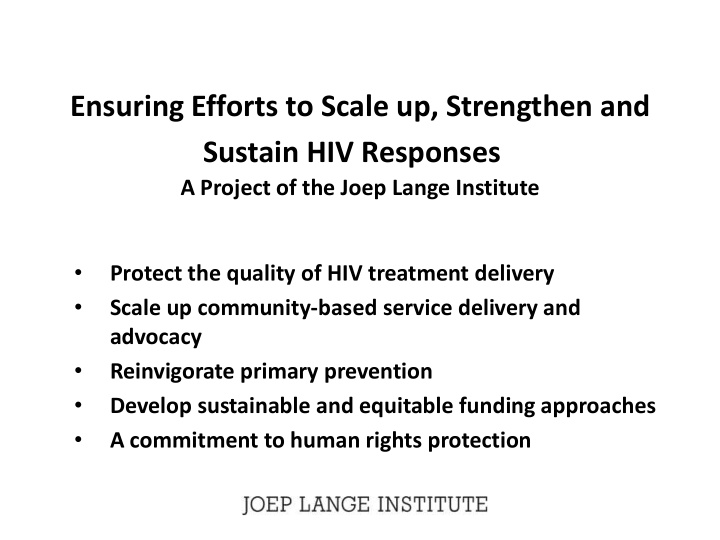



Ensuring Efforts to Scale up, Strengthen and Sustain HIV Responses A Project of the Joep Lange Institute • Protect the quality of HIV treatment delivery • Scale up community-based service delivery and advocacy • Reinvigorate primary prevention • Develop sustainable and equitable funding approaches • A commitment to human rights protection
Challenges to Maintaining the Quality and Effectiveness of HIV Treatment • Key populations are not reaching 90-90-90 goals • Young adults and adolescents are not adequately engaged in testing or treatment • Drug resistance rates are rising • Drug shortages and stock-outs are widely reported • Health systems are overburdened and shortages of health care workers are widespread • Community systems are undervalued, underfunded, and under-utilized
Missed opportunities for HIV testing and linkage in key populations: gay men and other MSM Moscow India Source: UNIADS (2017)Ending AIDS: Progress Towards the 90-90-90 Targets
Missed opportunities: Treatment gaps in adolescents and young adults Similar gaps in viral suppression exist among young adults in Zimbabwe, which is facing insufficient funding for ARVs, human resource shortages, a deteriorating health system and heavy reliance on donor funding. Source: Zimbabwe Population-Based HIV Impact Assessment. ZIMPHIA 2015 – 2016
Pre-treatment NNRTI resistance in 11 LMICs Source: WHO HIV Drug Resistance Report 2017
• Adapted from: Phillips A., JID 2017 Rates of virologic failure and death are 23 times higher among people with pre-treatment NNRTI resistance who are treated with NNRTI- containing ART Adapted from: Phillips et al; JID 2017
Risk of ongoing HIVDR → untreatable HIV in LMICs
Dem. Rep. of Congo Source: MSF Stock out report, 2017
South Africa Source: MSF Stock out report, 2017
HCW Shortages • In Kenya, a critical shortage of all HIV healthcare workers threatens expansion of HIV services, and there are poor working conditions contribute to problems attracting and retaining staff, esp. in rural and high-burden areas. • In Malawi, severe HCW shortages threaten HIV scale-up: there are only 28 nurses and 2 doctors per 100,00 people. • In Namibia, high vacancy and attrition rates and poor geographic distribution of public healthcare workers pose a major threat to achieving targets; 70% of doctors work in the private system, yet only 20% of patients get their care through it. • Zambia has a critical shortage of HCW; approximately 40% of positions in the healthcare sector are vacant – more health workers are needed to enable scale-up of quality HIV/AIDS services; Source: PEPFAR (2016) Country Operational Plan Strategic Direction Summaries from Kenya, Malawi, Namibia and Zambia
Scale up resources for community-based responses • Governments should support community-based services for HIV treatment, prevention and support through funding, capacity building and technical support to CBOs and other independent entities engaged in HIV work. Such services should work in partnership with health systems. Social impact bonds tied to performance-based funding are one method to be explored to finance and expand community-driven work. • Governments should also review and update existing laws and regulations in order to provide social contracting mechanisms and to broaden the role that civil society can play in health services delivery, including drug dispensary and HIV testing and counselling. • The Global Fund and other donors should develop and support funding mechanisms for CBOs working at national, regional and global levels to advocate for human rights protections and provide technical support to local community-based service providers. • CBOs and civil society groups must ensure that they establish the systems and procedures necessary to show how, why and where they are using increased funding.
Confront HIV drug resistance (HIVDR): Growing rates of drug resistance represent a real and significant threat to the continued success of the HIV response. • WHO should take the lead in developing simplified messaging regarding HIVDR to help those outside of the research community understand its relevance and importance, including all donors, government health officials and policy makers, CBOs and other CSOs. • Governments should (1) invest in increased laboratory capacity to better detect drug resistance and expand access to viral load testing; (2) invest in community-based, mobile technology-based and other adherence support services; and (3) ensure that supply chains can provide ARVs consistently without stock-outs or shortages at clinics. And, governments and donors must commit to ensuring access to second- and third line regimens so that treatment options are available for people with HIVDR. • WHO, UNAIDS, governments and researchers should initiate a rapid, comprehensive analysis of DTG to give a more thorough understanding of its risks and opportunities, including for treatment-naïve individuals.
Realize the promise of new and mobile technology: Digital technologies deserve special attention as potential solutions for building and sustaining comprehensive, quality HIV responses • WHO should develop guidelines for digital solutions. WHO indicators for quality of care by providers could be supplemented with a new set of mobile phone-based early warning indicators (EWIs) that are used by clients and communities to report on quality of care in a geo-targeted and real-time manner. • Governments and donors should strengthen links with private-sector partners with expertise in digital technologies that are adaptable in specific contexts, including resource-constrained ones. In particular, linkage to mobile phone providers will allow for using new sets of data that can help target HIV treatment and prevention efforts and identify vulnerable populations as well as potential hotspots of HIV. • Governments, donors and other external partners (e.g., foundations), also should establish and prioritize incentive-based programs that reward new and promising digital solutions targeted toward improving overall HIV responses and the experiences of the most vulnerable and key populations in particular. • Entrepreneurs in mobile technologies should be stimulated to come up with digital solutions that support HIV prevention, ART supply chain management, HIV treatment and care and empower individuals as well as communities in monitoring and securing determinants of quality of care.
Recommend
More recommend